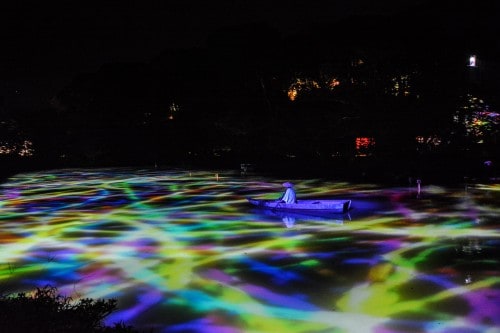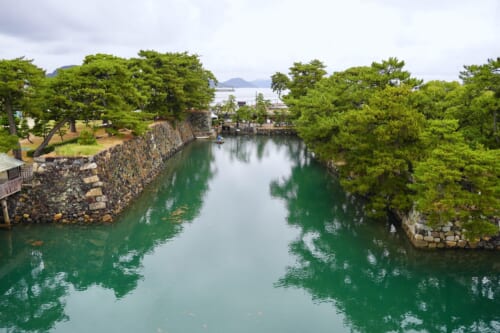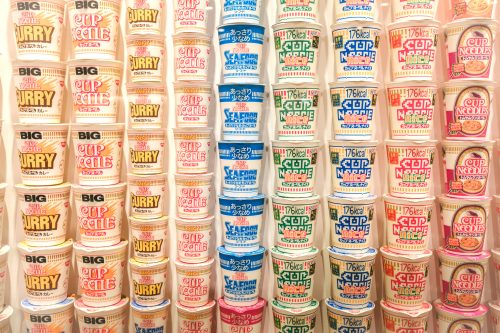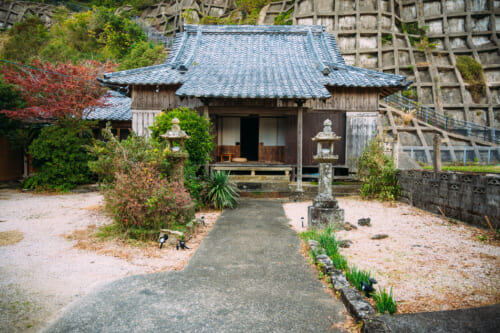Throughout history, humans have always sought to explain the mysterious or illogical phenomena around them. To make sense of what couldn’t be easily understood, we created myths and legends that have endured for centuries. These stories often feature extraordinary beings, gods, heroes, and monsters. In Japanese mythology, many of these tales involve yokai 妖怪 (supernatural creatures) that dwell in the realm between the known and the unknown.
Yokai and Their Origin in Japan
A yokai is a mysterious phenomenon beyond human understanding that can only be explained as a supernatural entity. They’re part of Japan’s tradition and culture, particularly rooted in small towns and villages, where they are passed down from generation to generation. These monsters move across the confusing boundaries between reality and fiction, conviction and disbelief, good and evil.
According to the Kojien dictionary 広辞苑, one of Japan’s most prestigious dictionaries, Yokai means:
【Yokai】 1. A strange creature or phenomenon that cannot be explained by human knowledge 2. Monster
In other words, when something strange occurred beyond human understanding, it was attributed to a yokai. To grasp their origin, one must consider life in Japan centuries ago, before modern technology and instant information.
Picture yourself on a dimly lit road in rural Japan, long before modern technology. News travels only through traders and local rumors. It’s a rainy summer night, so quiet you hear your own breath. Suddenly, a cold draft brushes your neck, and something strikes your leg. You turn, but no one is there.
Today, science might explain such phenomena, but centuries ago in rural Japan, people turned to yokai for answers. Over time, these creatures became embedded in daily life, tradition, and culture. Even now, belief in yokai remains deeply rooted, with them often linked to unexplained events.
Where Do Japanese Yokai Live? When Do They Appear?
The origin of yokai is rooted in Shinto principles, including animism and nature worship. Shinto is the oldest religion in Japan, and its name, Shinto 神道 means “the way of the gods.” It’s based on the worship of the kami 神 (deity) and according to its beliefs, these gods are found everywhere, both in nature and in animate and inanimate beings.
For this reason, yokai are on the border between “this world” and “the other world.” Many live in sacred natural spaces like mountains, forests, and rivers, avoiding human contact. Others, like the tsukumogami 付喪神, coexist with our world, manifesting in tools and traditional Japanese objects.
As beings of the in-between, yokai often appear at twilight, when day and night blur, or on overcast days, when sunlight barely pierces the clouds.
The Night Parade of 100 Demons in Japan
In Japan, many legends tell of yokai parades known as Hyakki Yagyo 百鬼夜行, or “The Night Parade of 100 Demons.” These events are said to occur on warm summer nights or during Obon お盆, a Buddhist holiday when spirits visit their living families.
Legends claim that yokai would lure humans into the streets on these nights, seizing the chance to kill those who dared to witness the eerie procession. According to Shugaisho 拾芥抄, an ancient Japanese encyclopedia, Onmyoji 陰陽師 — esoteric practitioners and fortune tellers — could use the Chinese zodiac to predict when these events might happen. The only way to stay safe during a yokai parade is to remain locked indoors.
Japan’s Most Famous Yokai Creatures and Monsters
There are many types of yokai in Japan. They come in many forms—animal-like, human-like, object-like, or even shapeless. Their nature ranges from evil to mischievous or benevolent, often wielding supernatural powers for both good and harm. Here are some of Japan’s most famous yokai, are you ready?
Oni: Japanese Demons
Oni 鬼 are the strongest, most violent, and most dangerous yokai resembling ogres or demons, with red, blue, or green bodies, horns, and fangs, often wielding iron maces. Rooted in Buddhism, they guard hell’s gates and torment the damned.
These yokai are the protagonists of the Setsubun, a Japanese holiday celebrated in early February, the day before the beginning of spring according to the lunar calendar. It’s believed that on this day, oni visits Japanese homes. To scare them away, among other things, house doors are decorated with dried fish heads and holly branches.
Tengu: The Guardians of the Mountain
Tengu 天狗 dwell deep in the mountains and are closely tied to them. Despite their name, meaning “heavenly dog,” they don’t resemble dogs. Tengu are stout, with red faces, long noses, wings for flight, and often carry feathered fans. They have various magical powers, including the ability to control the weather.
They move through the mountain with great dexterity, emitting noises, whispers, laughter, or drumming sounds that could terrify even the bravest. They’re especially dangerous for the elderly and children as they enjoy kidnapping the most defenseless.
Kappa: The Monsters of the Rivers
Kappa 河童 are among Japan’s most famous yokai. At one point, their existence was even believed, with mummified remains resembling these creatures being discovered. Living in freshwater, they were seen in Shinto as deities of rivers and lakes. Kappa are amphibian-like in appearance and often depicted with a turtle-like shell.
The kappa’s most notable feature is a water-filled dish on its head, which serves as its life source. If the water spills, the kappa will die. To defeat one, simply bow—its politeness will compel it to bow back, spilling the water. Kappa are known for eavesdropping, scolding women, and their peculiar fondness for babies, though not for play, but as a preferred meal.
Tanuki: The Masters of Disguise
The tanuki 狸 is a shapeshifting trickster resembling a large raccoon-dog. Its most unusual feature is its magical testicles, which it uses for various transformations, from weapons and umbrellas to cloaks for hiding. Tanuki also mimics human activities like drinking, gambling, and performing Buddhist rituals. While they mostly enjoy playing pranks, they can be dangerous when provoked.
Tanuki are very popular yokai in Japan and are a good fortune symbol for businesses. It’s very common to see tanuki figures with large testicles at the doors of shops and restaurants to attract good luck. There’s also a real tanuki, the Japanese raccoon, which despite its similar appearance to a large raccoon, actually belongs to the canid family.
Tsukumogami: Objects That Come to Life
In Shintoism, all beings, animate or inanimate, are believed to have a soul. Tsukumogami 付喪神 are yokai born when objects, after 100 years, gain a soul and come to life. These spirits can be benevolent, bringing good luck, or malevolent, especially if the object was mistreated or discarded.
According to legend, during the Heian period (794–1185), a citywide cleanup in Kyoto led to discarded objects feeling rejected and parading through the streets to seek revenge. Tsukumogami can take many forms, from kitchen utensils and tools to clothes, books, and furniture.
This belief remains alive in Japan today. Offerings are sometimes made to tools to honor their spirits, and broken objects are brought to shrines for peaceful disposal, preventing them from turning into malicious yokai.
Yokai and Yurei: Are They Monsters or Ghosts?
Japanese folklore has been studied for centuries and some researchers include yurei ghosts as a subgroup of the Japanese yokai. On the other hand, others believe they belong to a different category. What seems to be agreed upon by everyone is that there’s a big difference between these supernatural beings.
The yurei are the spirits or ghosts of the deceased who, in general, appear to people or in specific places because of some matters that were left unresolved during their earthly life. On the other hand, yokai are not considered spirits or ghosts because they’re not dead souls. They’re still alive but move in another dimension of space and time different from ours.
Yokai in Japan Today
Yokai have been part of Japanese culture for centuries but gained significant popularity during the Edo period (1603–1867), driven by the publishing boom and writers exploring their stories. In Miyoshi, Hiroshima Prefecture, the Miyoshi Mononoke Museum—the first dedicated to yokai—houses much of Koichi Yumoto’s renowned yokai art collection.
In recent decades, the global spread of Japanese video games, films, anime, and manga has brought yokai to a wider audience. This enduring presence is largely thanks to Shigeru Mizuki 水木しげる, one of Japan’s most famous manga authors, who focused much of his work on yokai. His series Gegege no Kitaro ゲゲゲの鬼太郎 shaped the image of yokai for many Japanese people. Mizuki’s legacy is celebrated with a museum in his hometown of Sakaiminato and a shop-museum near Tokyo’s Jindaiji Temple, where he lived until his passing.
Yokai have also influenced major franchises like Pokémon, with many characters inspired by Japanese folklore. Creatures such as oni, tengu, kappa, tanuki, and tsukumogami are reflected in Pokémon designs, connecting these ancient beings to modern pop culture.
Yokai have undeniably shaped Japanese society and culture, with countless stories passed down through generations. Each yokai carries its own tale, deeply rooted in tradition. Perhaps one night, on a quiet Japanese summer evening, you’ll feel a tap on your leg or a strange breeze on your neck. Whether it’s a coincidence or a playful yokai is for you to decide. Belief in their existence is yours to choose.







Yokai: Discover the History of Japan’s Legendary Monsters offers a captivating journey into the rich folklore and eerie legends of Japan. With its detailed explorations and vivid illustrations, the book brings to life the mysterious and fascinating world of Yokai. A must-read for anyone interested in Japanese culture and mythology!